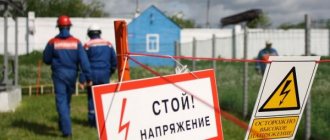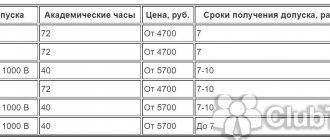Who needs electrical safety training?
For ease of understanding, we will divide all personnel into “categories”:
- electrical (electrical) personnel (workers dealing with electrical equipment, electrical installations or power tools). This category of workers is assigned electrical safety group II-V (with the issuance of certificates);
- non-electrical personnel (workers who are not directly related to the repair and installation of electrical equipment, but use electrical devices to perform their duties (PC, printer, fax, other electrical devices) and perform work that may pose a risk of electric shock). This category of workers is assigned electrical safety group I (without issuing certificates).
The concept of induction training on electrical safety does not exist. Electrical safety training is carried out only for assignment to group I.
And to assign an employee a higher group, i.e. II – V gr., here you won’t get by with simple instructions. To do this, the employee must undergo a special training course at the training center in accordance with the training programs. Training programs differ in content for different qualification groups. After testing knowledge and passing exams, the employee is issued a certificate for the appropriate access group.
Based on the above, electrical safety training is carried out for all employees of the organization, except electrical personnel.
And the concept of “instruction” is applicable only for workers with electrical safety group I.
Access groups for various categories of personnel
According to the IPBEE (Inter-industry Occupational Safety and Health Rules), production personnel whose professional activities are related to electrical installations of any type are usually divided into three categories:
- Electrotechnical.
- Electrotechnological.
- Non-electrical.
Let's consider the features of assigning an electrical safety permit.
Electrotechnical
For this category, electrical safety approvals from II to V are assigned, depending on the specific requirements for personnel. It, in turn, according to the IPBEE, is usually divided into the following subcategories:
- Administrative and technical . These are specialist managers whose responsibility includes organizing the maintenance process, as well as the operation of electrical equipment, including installation, adjustment and repair. The electrical safety clearance assigned to responsible managers must be no lower than that of subordinate production personnel.
- Operational. The personnel included in this subcategory are engaged in operational and technical maintenance of equipment that is part of the organization’s electrical facilities. In addition, the tasks include carrying out inspections and operational reconnections, as well as preparing workplaces (de-energizing, installing portable grounding, warning signs, etc.).
Installation of portable grounding - Repair . Workers in this subcategory are assigned tasks related to installation and repair work and reconstruction of electrical installations. Repair personnel include employees of instrumentation and control equipment, measurement laboratories and other services of relevant specialization.
- Operational and repair room . It includes electrical personnel assigned to specific areas. For example, shop electricians who specialize in servicing certain electrical equipment.
For independent activities, the last three subcategories must have a tolerance of at least 3, if the work is carried out with a voltage class of up to 1000 V. Accordingly, to carry out work with a higher voltage, it is necessary to have at least the IV tolerance group.
Electrotechnological
This category includes personnel whose professional activities involve the use of equipment powered by electrical energy. Examples include welding machines, as well as manual and stationary electrical equipment. Personnel are allowed to work after being assigned the 2nd qualification safety group.
Non-electrical
This definition includes personnel not included in the two previous categories. They are assigned the 1st clearance group. Which professions are included in this category is determined by the head of the enterprise.
What documents should there be?
To conduct training with assignment to Group I, you must complete a number of mandatory documents:
- List of professions and types of work that require assignment to group I in electrical safety. This list is approved by a local document, as a rule, this is an order (instruction) for the enterprise.
- A training program for assigning electrical safety group I, which should contain general information on electrical safety, information about the effects of electric current on the body and recommendations for first aid in case of electric shock.
- Logbook for training on assignment of group I in electrical safety to non-electrical personnel.
Results
The company is obliged to conduct occupational safety training in production with each employee whose job functions include performing production tasks.
At the same time, it is important to know that the occurrence of such events as a natural disaster, the performance of one-time work, or the holding of a mass event requires the employer to conduct separate targeted training. The company should be entrusted with carrying out targeted training to the manager of the relevant work. At the same time, it is important not to forget to check employees for assimilation of the materials of the targeted briefing, and also to correctly reflect the fact of its implementation in the internal local documents of the company. At the same time, you must not forget that if special permitting documentation is drawn up to carry out work, then the fact of conducting targeted training must be reflected in it. You can find more complete information on the topic in ConsultantPlus. Free trial access to the system for 2 days.
Who can provide electrical safety training?
A responsible person from among the electrical personnel with an electrical safety group of at least III, who has been trained and appointed by order of the enterprise, can assign electrical safety group I (i.e., conduct instruction).
Order for the enterprise
In organizations (enterprises) with a small number of employees, in which a responsible person has not been appointed, the instruction is carried out by the head of the organization (he must also be certified accordingly).
It is also possible to conclude a civil contract or a service contract for reading electrical safety instructions with a person who has the appropriate permits.
What is occupational safety training and when should it be carried out?
Current labor legislation requires that the employing company provide workers with the necessary training system in the basics of safety at work.
For this purpose, the Labor Code of the Russian Federation obliges organizations to conduct certain types of training on labor protection (Articles 212, 225 of the Labor Code of the Russian Federation). The employee, in turn, is required by the Labor Code of the Russian Federation to undergo such instructions without fail (Article 214 of the Labor Code of the Russian Federation). Please pay attention! If for some reason a production specialist has not undergone such instruction, then the employing company will be obliged to prevent such a specialist from directly going to work (Article 212 of the Labor Code of the Russian Federation).
In the process of conducting occupational safety training, the enterprise needs to familiarize the specialist with the hazardous production factors that he may encounter in the process of performing the tasks facing him, explain to the employee the requirements for occupational safety and health at work (enshrined in the relevant local documents of the company), the norms of various internal regulations and instructions regarding occupational safety, as well as highlight the question of what methods and techniques can be used to safely perform production tasks. After the instruction has been carried out, you should verbally check how fully and correctly the person being instructed has mastered the material covered by the person conducting the instruction.
The types of training that a company should conduct upon the occurrence of certain events, as well as the general procedure for conducting training on labor protection in each specific case, are established by the resolution of the Ministry of Labor of the Russian Federation, the Ministry of Education of the Russian Federation “On the Procedure for Training in Labor Safety” dated January 13, 2003 No. 1/29 (hereinafter referred to as — Order No. 1/29).
In addition to the above-mentioned Order No. 1/29, when conducting various types of training of workers on labor protection, the company must necessarily take into account the norms of GOST 12.0.230-2007, approved by Order of Rostekhregulirovanie dated July 10, 2007 No. 169-st.
In practice, companies often have questions: what types of briefings need to be carried out, and where are the uniform rules for conducting specific types of briefings (how often, in what time frame, etc.)? It all depends on the industry in which the company operates. Order No. 1/29 contains only a general algorithm regarding the conduct of labor safety briefings in certain situations. Specific terms and procedures for conducting briefings (of different types) in relation to individual industries are fixed in industry-specific or inter-industry regulations (clause 2.1.8 of Procedure No. 1/29). Therefore, companies should focus specifically on them.
However, for all briefings there is a general documentation: upon completion of the briefing, the employing company should register this fact in the briefing log, indicating what kind of briefing was carried out, on what dates, and also certified by the signatures of both parties (instructor and employee).
In addition, in practice, the issue of conducting fire safety training is also relevant for companies. More about this in the article “How to conduct fire safety training (nuances)” .
What is contained in the electrical safety group certificate?
This document confirms technical training and permission to work in consumer electrical installations. The employee must always have the certificate and present it if such a requirement follows, for example from the security of the facility. The certificate contains the following information (see Fig. 5):
On the left inner side:
- Document Number.
- Full name of the employee to whom the certificate was issued.
- Employee's position.
- Permissible voltage class.
- Which personnel does the employee belong to?
- The date of issue of the certificate and the name of the organization to which the permit is authorized to be assigned.
- Round seal and signature of the head.
On the right inside side of the ID there is a table with the results of the knowledge test.
Designations:
- Date of inspection.
- Reason for inspection (for example, regular, unscheduled, etc.).
- Assigned group.
- Grade.
- Indication of the date of the next (next) certification.
- Signature of the person who conducted the certification.
How and where do you take the electrical safety exam?
There are two options for carrying out the certification procedure:
- Conducting special training directly on site, followed by examinations by members of the enterprise’s permanent commission, which determines the list of questions. After the exam, the appropriate group is assigned, an entry is made in a special journal and an admission certificate is issued.
Figure 5. Electrical safety certificate and knowledge test log - By order of the head of the enterprise, electrical safety training can take place at the local branch of Rostechnadzor. There, a group is assigned to employees and an admission certificate is issued.
Permits
Occupational safety in construction and labor protection
Permits for work at various production facilities are certificates of compliance with a certain admission group, as well as categories of personnel depending on the work performed. These documents confirm the presence of special knowledge and skills in handling power tools, as well as knowledge in the field of labor protection.
Note! Categories are assigned during the training process at the enterprise or in special training centers, depending on work experience and production skills.
Personnel classification
The classification of personnel is based on interaction with devices during operation, as well as the availability of special knowledge in this area:
- Administrative and technical personnel practically do not interact with devices during work, but organize the work of other services and departments;
- Repair personnel are engaged and specialized in carrying out repair work on installations or electrical networks;
- The operational and repair department acts as separate staff units, the function of which is to carry out repairs of complex installations and requires confirmation of knowledge as part of certification;
- personnel at production sites work directly on electrical equipment under high voltage every day. To do this, in addition to a course of special knowledge, it is necessary to undergo special training and a medical examination. It is in relation to this category that special groups of admission to installations are applied.
Rules for the use of electrical equipment and handling of devices during work activities
Serviceable electrical equipment
There should be theoretical training and instruction, that goes without saying. But the equipment must also be in good working order and used without violations. It is forbidden:
- Overload sockets, especially tees;
- Use a large number of extension cords that lie haphazardly on the floor;
- Hide wires under the covering, especially carpet or carpet.
The insulation must be in good condition; cracks, abrasions, and kinks are not allowed. Electrical tape (and most often in offices they use regular tape for this) is also extremely undesirable. Twisted wires, damaged sockets and plugs are especially dangerous.
Of course, there must be automatic power shut-off devices - RCDs (residual current devices). The wiring must be in good working order; if it is not hidden in the wall, then at least laid in special boxes that do not support combustion.
And of course, you can only use office equipment that is in working order, not dusty, with proper ventilation and cooling (this applies to computers). The same applies to heating appliances in terms of serviceability - electric kettle, microwave, heater. In general, there is a separate point with heaters - do not place them next to flammable things - clothes, curtains, paper.









